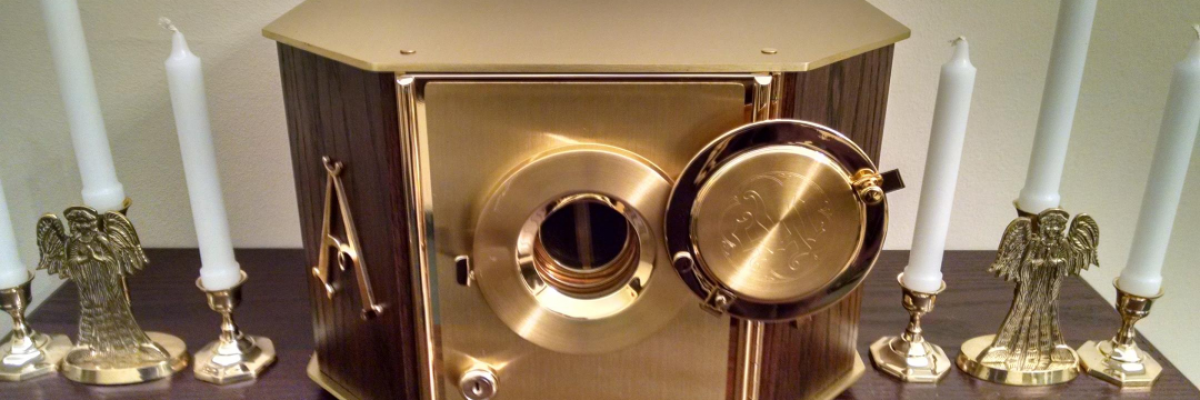
During the COVID-19 crisis, the closest most of us have been able to approach our Eucharistic Lord is through spiritual communion while watching Mass on TV or online. Some have had access to the Blessed Sacrament in adoration at their parish churches, with or without exposition. Under any circumstances, this is an incredible blessing, as Mother Teresa so eloquently put it:
The time you spend with Jesus in the Blessed Sacrament is the best time you will spend on earth. Each moment that you spend with Jesus will deepen your union with Him and make your soul everlastingly more glorious and beautiful in Heaven, and will help bring about everlasting peace on earth.
With questions about Eucharistic adoration being publicly discussed during the pandemic, Catholic Answers received a question recently about adoration chapels in which an adorer can open a tabernacle door exposing the Blessed Sacrament, yet the Eucharist remains protected behind a sturdy see-through window (see accompanying photo). The accommodation means that priests don’t need to expose and repose the Eucharist during the day. Instead, they simply direct their parishioners to open the tabernacle door for adoration and then close it when they’re done.
I have visited such a chapel, but I didn’t open the tabernacle because it isn’t clear that such “window” tabernacles are permissible under the Church’s current liturgical guidelines. The Holy See provides norms for eucharistic adoration with exposition in its 1973 document Eucharistiae Sacramentum (Holy Communion and Worship of the Eucharist Outside Mass), published by the predecessor of the Congregation for Divine Worship and Discipline of the Sacraments (CDWDS). The relevant discipline can be found in paragraph 88:
Where there cannot be uninterrupted exposition because there is not a sufficient number of worshipers, it is permissible to replace the Blessed Sacrament in the tabernacle at fixed hours that are announced ahead of time. But this may not be done more than twice a day, for example, at midday and at night.
The following form of simple reposition may be observed: the priest or deacon, vested in an alb, or a surplice over a cassock, and a stole, replaces the blessed sacrament in the tabernacle after a brief period of adoration and a prayer said with those present. The exposition of the Blessed Sacrament may take place again, in the same manner and at a scheduled time (emphasis added).
The 2004 document Redemptionis Sacramentum (On Certain Matters to be Observed or to Be Avoided Regarding the Most Holy Eucharist), while reaffirming important teaching and issuing various disciplinary norms, does not alter Eucharistiae Sacramentum on the discipline in question, so the previous provisions remain in place.
Thus, while tabernacles with “windows” are designed to increase devotion, they do not seem consistent with the Church’s norms absent a formal dispensation from the Holy See, which a bishop can request from the CDWDS.
Implementing perpetual adoration with exposition is a major commitment for any parish and is nearly impossible for many given the manpower needed to sustain such devotion throughout the year. Still, in Eucharistiae Sacramentum, the Holy See provides a useful alternative that could be employed while pastors and their bishops seek clarification on whether they can use tabernacles designed to make adoration with exposition more easily accessible to the faithful:
In the absence of a priest or deacon or if they are lawfully impeded, the following persons may publicly expose and later repose the Eucharist for the adoration of the faithful:
- an acolyte or special minister of Communion;
- upon appointment by the local Ordinary, a member of a religious community or of a pious association of laymen or laywomen which is devoted to eucharistic adoration.
Such ministers may open the tabernacle and also, as required, place the ciborium on the altar or place the host in the monstrance. At the end of the period of adoration, they replace the Blessed Sacrament in the tabernacle. It is not lawful, however, for them to give the blessing with the Sacrament.
The minister, if he is a priest or deacon, should vest in an alb, or a surplice over a cassock, and a stole. Other ministers should wear either the liturgical vestments that are used in the region or the vesture that is befitting this ministry and is approved by the Ordinary (91-92).
In other words, at specific times for each day of the week, in conformity with liturgical norms, lay persons could assist their pastors in making adoration with exposition more available.
Prudential concerns about social distancing remain, however, and should not be ignored. Some pastors have made adoration available to limited numbers in the main sanctuary, where adorers can space themselves adequately. Others have strictly limited numbers in adoration chapels and ensured that surfaces are regularly sterilized.
As we pray for the pandemic to end and restrictions to be rolled back accordingly, we can also pray the crisis serves as a blessing in disguise—that deprivation of the Blessed Sacrament would make our hearts grow fonder. We should never take lightly the Eucharist or any of the sacraments—God’s quintessential gifts for us to participate and grow in intimate communion with him. When this pandemic ends, may we renew our participation in the sacraments and thereby advance the kingdom, more fruitfully than ever (Rom. 8:28).



